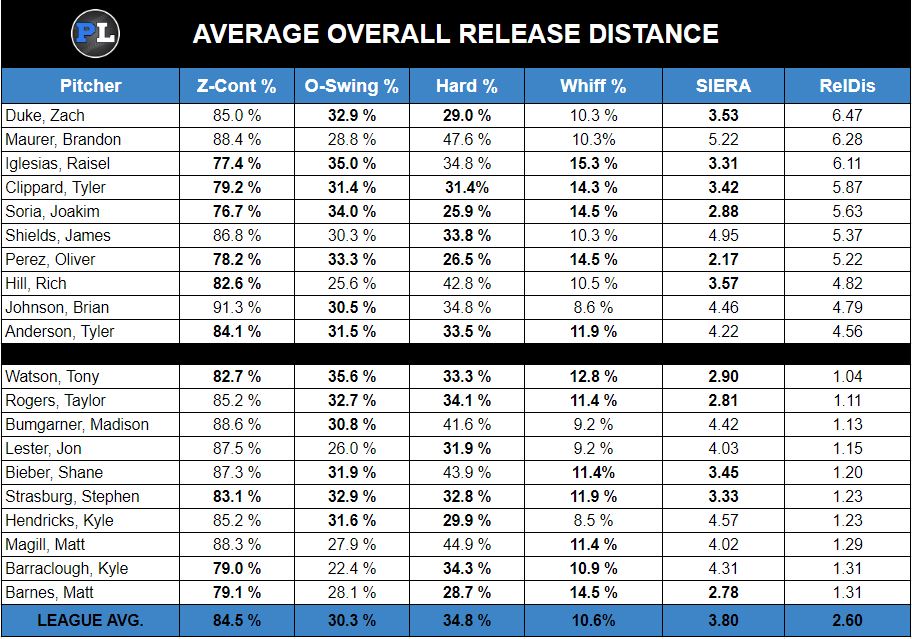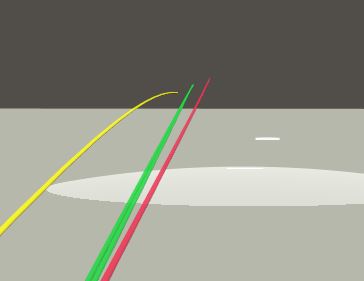When speaking to the intake of visual information, Major League Baseball hitters have great eyes. In fact, it’s not uncommon for them to have something in the neighborhood of 20/10 vision. Their eyes have to pass information more quickly and efficiently than the blink of an eye. Because of this, pitchers have to work hard to avoid being clocked by a hitter. One way they can combat this biological irregularity is by tightening up their release points.
Take the Washington Nationals‘ Stephen Strasburg. His overall release points for all pitches in 2018 was one of the closest in the league.
Generally speaking, release points are pretty close to the untrained eye. However, an athlete with above average eyesight can pick out differences in fractions of an inch. If a hitter is able to identify the pitch, it makes him that much more prepared to make good contact. Let’s say you hammer the strike zone with 95+ mph fastballs, change speeds and timing by mixing in your offspeed pitches, and/or paint the corners with your breaking stuff. You look really good—good enough to at least be a middle-rotation starter or a late-inning bullpen arm. Could more consistent release points turn you into something of an ace or even a shutdown reliever/closer?
To begin this assessment, I used the Baseball Prospectus’ Pitch Tunnel stats to find the largest and smallest average release point spreads (in inches) from 2018, with a minimum of 50 IP. I looked at contact in the zone and chase rate, as those are two good markers for how well a pitcher keeps a hitter guessing. I also checked to see if the extreme differences lend themselves to the reinforcement of dense release points. Meaning, do the best performers get a higher rate of missed and/or chased pitches? Hard hit rate was included as it tends to indicate how often a hitter is ready for what a pitcher is throwing (among other factors). Do wildly varying release points better prepare a hitter to make hard contact? In an attempt to consider all aspects of a pitcher’s performance, I chose to include SIERA as the metric of pitching success, as I consider it the best marker for how a pitcher did throughout the year.

While this chart represents a small sample of pitchers, using extremes can still reap some useful information. However, in this case, there doesn’t seem to be a correlation between the average release point and successful pitching. You see a fair spread of bold (better than league average) numbers on both lists. Is this the case across the board? It’s possible, but I think that there is too much context left out of these numbers. Furthermore, if you look at whiff rate, the pitchers with greater distance actually performed better by 1%. The group of pitchers with close release points had a clear advantage when it came to hard-hit rate. You could reasonably conclude that a concentrated release locus elicits more guessing from a hitter. We could elaborate further if we included how well the above-average group tunneled their pitches, thereby giving the chart more context, but I’m not about to open that can of worms just this minute.
Instead, let’s take a look at two of the most adequate examples in both groups: the Pittsburgh Pirates‘ Brandon Maurer (with the Kansas City Royals in 2018) and Tony Watson of the San Francisco Giants.
Despite Zach Duke having the greatest of the substandard release metrics, I chose Maurer because he was worse than league-average in each category and had the second-largest release spread. Maurer has three main pitches: a four-seam fastball, a slider, and a changeup. The average difference in horizontal release point between his fastball and slider is almost 3/4 of an inch. His changeup is a bit closer but holds an average of a 1/2-inch difference. His median vertical release points aren’t much better. As mentioned earlier, an inch imbalance in release point might not make that much of a difference to a ‘normal’ eye, but an eagle-eyed hitter will pick up on that. Not only that, these are averages, so the release disparity can be much larger (or smaller) on a pitch-by-pitch basis.
Below is a three-pitch overlay sampling of Maurer’s release points.
Here is the 3D pitch visualization from the hitter’s point of view.

Now we go to the other end of the spectrum with Watson. The three-pitch overlay below reveals identical release points.
Watson’s average release points between all of his pitches vary by hundredths of an inch, both vertically and horizontally, and his mechanics are ideal. The release points for all of his offerings from the game against the Pirates, shown in the GIF above, are quite a contrast to Maurer’s.

We can guess that if you’ve got solid ’stuff’ then you can get away with varied release points, especially if you know how to sequence right. On the contrary, just because you have tight release points, you are not guaranteed successful pitching. As a matter of fact, the pitchers with the furthest distance between release points have more above average SIERA stats than those with the least distance. Again, this isn’t concrete, but it gives us a good idea of what’s going on. Long story short, just like I mentioned with velocity, you don’t need to have close release points, but they certainly don’t hurt.
I also want to point out that there are a lot of pitchers who are really good and don’t have the tightest release points; they aren’t present in either group. Tight release points aren’t crucial, akin to how a guy can be successful when throwing his fastball in the low 90s. Sure, throwing harder could improve some of his stats, but if he has proven successful without high velocity, should he mess with his approach? It’s hard to say. Would you advise him of the benefits of keeping release points precise? If he were to take you up on that suggestion, it could be either a rousing success for him or it could screw up his mechanics and suddenly he’s not the same pitcher. The old “ain’t broke, don’t fix” adage applies here, but generally speaking, keeping taut release points is a skill worth mastering.
Still, there is much more to consider. Take a look at arm angles, for example. Regardless of where a pitcher is releasing his pitch, if he has varied arm angles, that can be a dead giveaway of what a hitter is about to see. We could go one step further and investigate tunneling ability. You could easily surmise that to create an effective pitch tunnel, one which keeps hitters unsure until the last possible second, a pitcher would want close release points. Then there is arm extension: from what distance the ball is released. In this case, pitchers can ‘create’ a higher velocity (known as Perceived Velocity) due to manipulation of depth perception. To piggyback off all of that, we could also appraise spin axis, which has a profound effect on where a pitch ends up after it is let go. A pitcher can have an all-over-the-place delivery, but because his movement is so unpredictable to a batter, it can sometimes not matter if the batter expects the pitch or not.
It’s clear that release points matter depending on the circumstances. Some pitchers have to be precise, others can pretty much do whatever they want (though the latter type is typically few and far between). In the end, they just serve as another tool to help identify pitching success, or as a marker to identify some room for improvement.
(Photo by Jacob Snow/Icon Sportswire)
